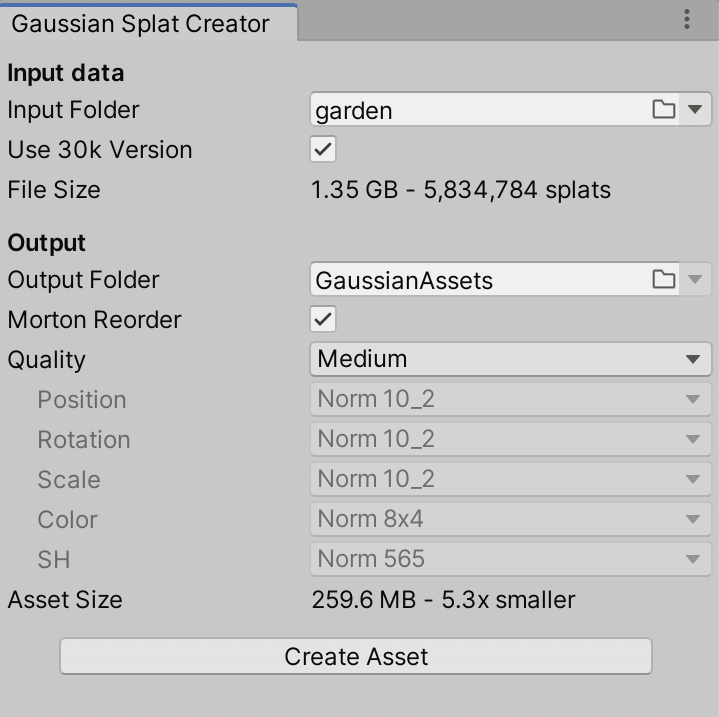SIGGRAPH 2023 had a paper "3D Gaussian Splatting for Real-Time Radiance Field Rendering" by Kerbl, Kopanas, Leimkühler, Drettakis that looks pretty cool! Check out their website, source code repository, data sets and so on.
I've decided to try to implement the realtime visualization part (i.e. the one that takes already-produced gaussian splat "model" file) in Unity.
The original paper code has a purely CUDA-based realtime renderer; other people have done their own implementations (e.g. WebGPU at cvlab-epfl, Taichi at wanmeihuali, etc.).
Code in here so far is randomly cribbled together from reading the paper (as well as earlier literature on EWA splatting), looking at the official CUDA implementation, and so on. Current state:
- The code does not use the "tile-based splat rasterizer" bit from the paper; it just draws each gaussian splat as an oriented quad that covers the extents of it.
- Splat color accumulation is done by rendering front-to-back, with a blending mode that results in the same accumulated color as their tile-based renderer.
- Splat sorting is done with a AMD FidelityFX derived radix sort.
Download or clone this repository and open projects/GaussianExample as a Unity project (I use Unity 2022.3, other versions might also work).
Note that the project requires DX12 or Vulkan on Windows, i.e. DX11 will not work. This is not tested at all on mobile/web, and probably
does not work there.
Next up, create some GaussianSplat assets: open Tools -> Gaussian Splats -> Create GaussianSplatAsset menu within Unity.
In the dialog, point Input PLY File to your Gaussian Splat file (note that it has to be a gaussian splat PLY file, not some
other PLY file. E.g. in the official paper models, the correct files are under point_cloud/iteration_*/point_cloud.ply).
Optionally there can be cameras.json next to it or somewhere in parent folders.
Pick desired compression options and output folder, and press "Create Asset" button. The compression even at "very low" quality setting is decently usable, e.g.
this capture at Very Low preset is under 8MB of total size (click to see the video):
If everything was fine, there should be a GaussianSplat asset that has several data files next to it.
Since the gaussian splat models are quite large, I have not included any in this Github repo. The original paper github page has a a link to 14GB zip of their models.
In the game object that has a GaussianSplatRenderer script, point the Asset field to one of your created assets.
There are various controls on the script to debug/visualize the data, as well as a slider to move game camera into one of asset's camera
locations.
The rendering takes game object transformation matrix into account; the official gaussian splat models seem to be all rotated by about -160 degrees around X axis, and mirrored around Z axis, so in the sample scene the object has such a transform set up.
Additional documentation:
That's it!
Future plans, roadmap and a todo list does not really exist, I'll just do whatever I randomly decide. I keep some of the open ideas as github issues.
My own blog posts about all this:
- Gaussian Splatting is pretty cool! (2023 Sep 5)
- Making Gaussian Splats smaller (2023 Sep 13)
- Making Gaussian Splats more smaller (2023 Sep 27)
"bicycle" scene from the paper, with 6.1M splats and first camera in there, rendering at 1200x797 resolution, at "Medium" asset quality level (282MB asset file):
- Windows (NVIDIA RTX 3080 Ti):
- Official SBIR viewer: 7.4ms (135FPS). 4.8GB VRAM usage.
- Unity, DX12 or Vulkan: 8.1ms (123FPS) - 4.55ms rendering, 2.37ms sorting, 0.78ms splat view calc. 1.3GB VRAM usage.
- Mac (Apple M1 Max):
- Unity, Metal: 23.6ms (42FPS).
Besides the gaussian splat asset that is loaded into GPU memory, currently this also needs about 48 bytes of GPU memory per splat (for sorting, caching view dependent data etc.).
The code I wrote for this is under MIT license. The project also uses several 3rd party libraries:
- zanders3/json, MIT license, (c) 2018 Alex Parker.
- "Ffx" GPU sorting code is based on AMD FidelityFX ParallelSort, MIT license, (c) 2020-2021 Advanced Micro Devices, Inc. Ported to Unity by me.
However, keep in mind that the license of the original paper implementation says that the official training software for the Gaussian Splats is for educational / academic / non-commercial purpose; commercial usage requires getting license from INRIA. That is: even if this viewer / integration into Unity is just "MIT license", you need to separately consider how did you get your Gaussian Splat PLY files.


